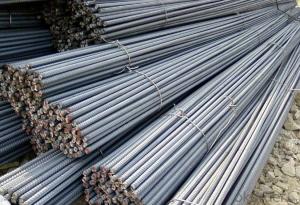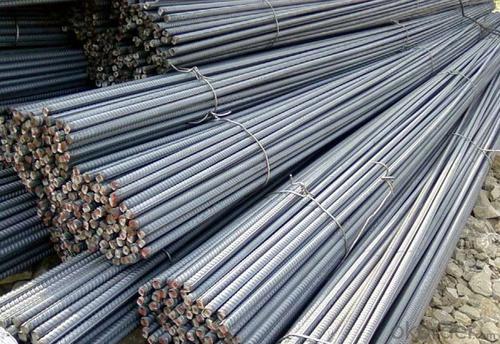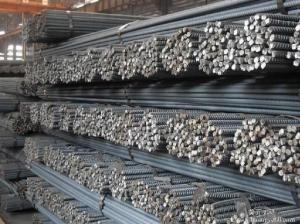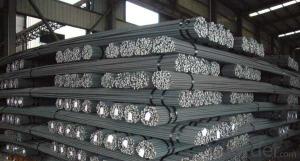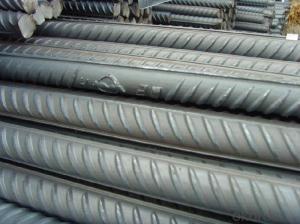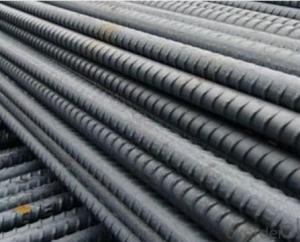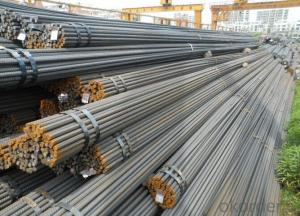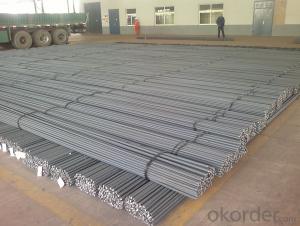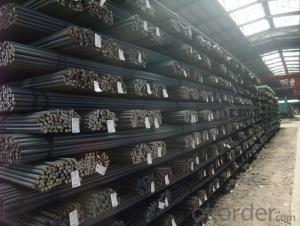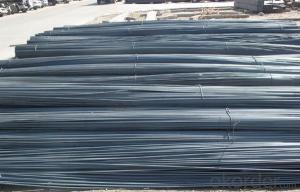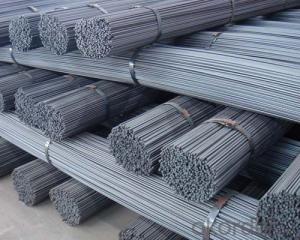Steel Rebar Strips For Building Construction
- Loading Port:
- China main port
- Payment Terms:
- TT OR LC
- Min Order Qty:
- 100 m.t.
- Supply Capability:
- 100000 m.t./month
OKorder Service Pledge
OKorder Financial Service
You Might Also Like
Usage and Applications
Deformed bar is widely used in buildings, bridges, roads and other engineering construction. Big to highways, railways, bridges, culverts, tunnels, public facilities such as flood control, dam, small to housing construction, beam, column, wall and the foundation of the plate, deformed bar is an integral structure material. With the development of world economy and the vigorous development of infrastructure construction, real estate, the demand for deformed bar will be larger and larger.
Diameter(mm) | Section area (mm²) | Mass(kg/m) | Weight of 12m bar(kg) |
6 | 28.27 | 0.222 | 2.664 |
8 | 50.27 | 0.395 | 4.74 |
10 | 78.54 | 0.617 | 7.404 |
12 | 113.1 | 0.888 | 10.656 |
14 | 153.9 | 1.21 | 14.52 |
16 | 201.1 | 1.58 | 18.96 |
18 | 254.5 | 2.00 | 24 |
20 | 314.2 | 2.47 | 29.64 |
22 | 380.1 | 2.98 | 35.76 |
25 | 490.9 | 3.85 | 46.2 |
28 | 615.8 | 4.83 | 57.96 |
32 | 804.2 | 6.31 | 75.72 |
36 | 1018 | 7.99 | 98.88 |
40 | 1257 | 9.87 | 118.44 |
50 | 1964 | 15.42 | 185.04 |
Packaging & Delivery
Packaging Detail: products are packed in bundle and then shipped by container or bulk vessel, deformed bar is usually naked strapping delivery, when storing, please pay attention to moisture proof. The performance of rust will produce adverse effect.
Each bundle weight: 2-3MT, or as required
Payment term: TT or L/C
Delivery Detail: within 45 days after received advanced payment or LC.
Label: to be specified by customer, generally, each bundle has 1-2 labels
Trade terms: FOB, CFR, CIF
Cold Rolled Techniques
Yield Point: 545-565mpa
Deformed bar is widely used in buildings, bridges, roads and other engineering construction. Big to highways, railways, bridges, culverts, tunnels, public facilities such as flood control, dam, small to housing construction, beam, column, wall and the foundation of the plate, deformed bar is an integral structure material. With the development of world economy and the vigorous development of infrastructure construction, real estate, the demand for deformed bar will be larger and larger.
- Q: What is the process of inspecting steel rebars before installation?
- The process of inspecting steel rebars before installation typically involves visually inspecting the rebars for any visible defects, such as corrosion, bending, or surface damage. Additionally, rebars are often checked for proper dimensions, including length, diameter, and shape. Non-destructive testing methods, such as ultrasonic or magnetic particle testing, may also be used to identify any internal flaws or defects. This inspection process ensures that the rebars meet the required standards and are suitable for installation in construction projects.
- Q: What are the different types of steel rebars used in marine constructions?
- The different types of steel rebars commonly used in marine constructions include stainless steel rebars, epoxy-coated rebars, and galvanized rebars. These types of rebars are chosen for their corrosion resistance properties, which are essential in withstanding the harsh marine environment. Stainless steel rebars are highly resistant to corrosion and are often used in marine structures due to their durability. Epoxy-coated rebars have a protective coating that prevents corrosion, making them suitable for marine applications. Galvanized rebars are coated with a layer of zinc, providing excellent corrosion protection and are commonly used in marine construction projects.
- Q: How do steel rebars affect the overall load distribution of concrete structures?
- Steel rebars play a critical role in the load distribution of concrete structures. They enhance the overall strength and durability of the concrete by providing reinforcement. When concrete is poured, it is strong in compression but weak in tension. Steel rebars are embedded within the concrete to counterbalance this weakness and distribute the load more evenly. The presence of steel rebars helps to prevent cracks and structural failures by absorbing and distributing the tensile forces exerted on the concrete. As the load is applied to the structure, the steel rebars effectively transfer the tension forces to the surrounding concrete, which is highly resistant to compression. This load transfer mechanism results in a more balanced distribution of forces throughout the structure. Furthermore, the use of steel rebars increases the overall stiffness of the concrete structure. By resisting deformation, the rebars help to maintain the structural integrity and prevent excessive deflection under load. This is particularly important in large-scale concrete structures such as bridges, high-rise buildings, and dams, where the load distribution needs to be carefully managed to ensure stability. In summary, steel rebars significantly influence the load distribution of concrete structures by reinforcing the concrete and enhancing its tensile strength. They work in synergy with the concrete to evenly distribute and transfer the load, preventing cracks and structural failures. The combination of steel rebars and concrete creates a robust and reliable structural system capable of withstanding the applied loads and ensuring long-term safety.
- Q: Are steel rebars suitable for use in industrial structures?
- Yes, steel rebars are suitable for use in industrial structures. Steel rebars, also known as reinforcing bars, are commonly used in the construction industry to provide added strength and stability to concrete structures. They are made from high-strength steel and have excellent tensile strength, making them ideal for reinforcing concrete in industrial structures that are subject to heavy loads, vibrations, or other dynamic forces. Steel rebars also have good ductility and can withstand bending without breaking, which is important in industrial structures where high structural integrity is required. Additionally, steel rebars have good resistance to corrosion, which is essential in industrial environments where exposure to moisture, chemicals, or other corrosive agents is common. Overall, steel rebars are a reliable and durable choice for reinforcing industrial structures, ensuring their long-term structural stability and safety.
- Q: How do steel rebars affect the flexural strength of reinforced concrete elements?
- Steel rebars significantly enhance the flexural strength of reinforced concrete elements by providing tensile strength to counteract the concrete's weakness in tension, resulting in a more durable and resilient structure.
- Q: Are there any limitations on the length of steel rebars?
- There are limitations on the length of steel rebars, which are typically set by industry standards and guidelines. These limitations are mainly determined by practical and logistical factors. One limitation is related to transportation and handling of rebars. Steel rebars are typically manufactured in long lengths, often up to 60 feet (18 meters) or more. However, due to the weight and stiffness of steel rebars, it becomes challenging to transport and maneuver such long lengths. Therefore, rebars are often cut into shorter lengths for ease of transportation and handling on construction sites. Another limitation is related to the structural integrity of the rebars. Longer rebars may be more prone to bending, warping, or sagging, which can compromise their effectiveness in reinforcing concrete structures. To ensure structural integrity, rebars are often limited to specific lengths based on the specific application and design requirements. Additionally, there may be limitations imposed by local building codes and regulations. These codes and regulations aim to ensure the safety and durability of structures. They may specify the maximum length of steel rebars that can be used in different construction applications to meet the required standards and ensure the structural integrity of the building. In summary, while steel rebars can be manufactured in long lengths, practical considerations, structural integrity, and local regulations often impose limitations on their length. These limitations are in place to ensure the efficient handling and transportation of rebars, maintain their structural integrity, and comply with building codes and regulations.
- Q: What are the different types of steel rebars used in marine construction?
- In marine construction projects, various types of steel rebars are utilized to withstand the harsh conditions and corrosive environments commonly found in marine structures. 1. Stainless Steel Rebars: These rebars, containing chromium and nickel, are crafted from high-grade stainless steel. They exhibit exceptional resistance to corrosion, making them ideal for marine construction projects where exposure to saltwater and other corrosive elements is anticipated. Though more expensive, stainless steel rebars offer superior durability and longevity. 2. Epoxy-Coated Rebars: Carbon steel rebars are coated with an epoxy layer, acting as a protective barrier against corrosive elements and reducing the risk of rust and corrosion. These rebars are commonly employed in marine construction projects with high saltwater exposure. 3. Galvanized Rebars: By subjecting carbon steel rebars to a hot-dip galvanization process, a layer of zinc is applied, providing excellent corrosion resistance. Galvanized rebars are frequently used in marine construction projects susceptible to seawater or salt spray exposure. 4. Fiberglass Rebars: Composed of high-strength glass fibers embedded in a polymer matrix, fiberglass rebars offer excellent corrosion resistance unaffected by saltwater or other corrosive elements. These rebars are lightweight, non-magnetic, and possess high tensile strength, making them suitable for marine construction projects. 5. Carbon Steel Rebars: Carbon steel rebars are the most commonly used rebars in construction, including marine projects. Although not inherently corrosion-resistant, they can be treated with protective coatings, such as epoxy or galvanization, to enhance their durability and resistance to corrosive environments. It is crucial to consider the specific requirements and conditions of a marine construction project when selecting the appropriate type of steel rebars. Factors such as saltwater exposure, humidity, and anticipated lifespan of the structure should be taken into account to ensure its longevity and safety.
- Q: How are steel rebars protected during construction?
- To ensure the longevity and structural integrity of steel rebars during construction, various methods are employed for their protection. One effective approach involves the application of epoxy coatings or corrosion-resistant paints. These coatings serve as a barrier between the steel rebar and the surrounding environment, effectively safeguarding it against moisture, chemicals, and other corrosive substances. Another means of protection involves the proper placement of rebars within the concrete. By embedding them at the specified depth, the rebars are shielded from potential exposure to external elements that could induce corrosion. Furthermore, concrete covers can be employed as an additional layer of defense. These covers act as physical barriers, encasing the rebars and safeguarding them against external factors. The thickness of the concrete cover is determined based on the specific environmental conditions and design requirements of the construction project. Moreover, the implementation of adequate drainage systems plays a crucial role in rebars' protection. By ensuring effective drainage, water accumulation around the steel rebars is minimized, thereby significantly reducing the risk of corrosion. Regular inspections and maintenance are of paramount importance in the protection of steel rebars during construction. Any signs of corrosion or damage should be promptly detected and repaired to prevent further degradation. In summary, a combination of epoxy coatings, proper placement within the concrete, concrete covers, drainage systems, and regular maintenance are indispensable for the protection of steel rebars during construction. These measures guarantee their durability and structural integrity for years to come.
- Q: What are the guidelines for handling and disposing of steel rebars after demolition?
- The guidelines for handling and disposing of steel rebars after demolition include the following: 1. Identification: It is important to identify the steel rebars and differentiate them from other construction debris. This can be done by marking or labeling the rebars appropriately. 2. Segregation: Separate the steel rebars from other waste materials on-site. This ensures that they can be properly handled and recycled or disposed of accordingly. 3. Demolition process: During the demolition process, care should be taken to minimize damage to the steel rebars. This includes using appropriate tools and techniques to avoid excessive bending or cutting, which can affect their recyclability. 4. Removal and transportation: After demolition, the steel rebars should be carefully removed from the site and transported to the designated area for further processing or disposal. This may involve the use of machinery or manual labor, depending on the quantity and size of the rebars. 5. Recycling: Steel rebars are highly recyclable and should be sent to a recycling facility whenever possible. These facilities can process the rebars and convert them into new steel products, reducing the need for extracting and manufacturing new materials. 6. Disposal: If recycling is not feasible, the steel rebars may need to be disposed of in accordance with local regulations. This may involve taking them to a designated landfill or waste disposal site that can handle construction materials. 7. Safety precautions: It is important to follow safety precautions when handling steel rebars. This includes wearing appropriate personal protective equipment (PPE) such as gloves and safety glasses, as well as using proper lifting techniques to prevent injuries. 8. Compliance with regulations: Ensure that all handling and disposal activities comply with local, state, and federal regulations. This may include obtaining necessary permits or licenses, as well as adhering to specific guidelines for waste management and recycling. By following these guidelines, the handling and disposal of steel rebars after demolition can be done in an environmentally responsible and safe manner, contributing to sustainable construction practices.
- Q: What are the guidelines for the proper anchoring of steel rebars in columns?
- The guidelines for the proper anchoring of steel rebars in columns are essential to ensure the structural integrity and safety of the reinforced concrete structure. These guidelines are typically based on industry standards and codes, such as the American Concrete Institute (ACI) Building Code Requirements for Structural Concrete (ACI 318). 1. Lap Length: The lap length is the minimum distance required for the overlapping of rebars to provide sufficient bond strength. It is determined based on the rebar diameter, grade, concrete strength, and design requirements. The ACI 318 provides specific formulas and tables to calculate the required lap length. 2. Embedment Length: The embedment length refers to the portion of the rebar that is embedded within the concrete column. It is important to achieve adequate embedment to transfer the applied loads effectively. The embedment length is determined based on factors such as rebar diameter, grade, and the compressive strength of concrete. 3. Development Length: The development length is the minimum length of rebar required beyond the point of critical section to develop its full tensile or compressive strength. It ensures that the rebar can resist the applied loads and prevent premature failure. The ACI 318 provides formulas to calculate the development length based on rebar diameter, grade, concrete strength, and design requirements. 4. Concrete Cover: The concrete cover refers to the thickness of concrete between the external surface of the rebar and the outer surface of the column. It provides protection against corrosion, fire, and other environmental factors. The required concrete cover is determined by considering factors such as rebar diameter, grade, exposure conditions, and design requirements. The ACI 318 provides minimum cover requirements for different rebar sizes and exposure conditions. 5. Spacing and Positioning: The rebars should be properly spaced and positioned within the column to ensure uniform load distribution and effective reinforcement. The spacing is determined based on the column dimensions, rebar diameter, and design requirements. Additionally, the rebars should be properly aligned and centered within the column to provide the intended structural strength. 6. Mechanical Anchorage: In some cases, mechanical anchorage devices, such as rebar couplers or headed bars, are used to improve the anchoring of rebars in columns. These devices provide enhanced load transfer and prevent slippage between rebars. The selection and installation of mechanical anchorage should comply with the manufacturer's recommendations and relevant standards. 7. Quality Control and Inspection: It is crucial to implement proper quality control and inspection procedures during the installation of rebars in columns. This includes verifying the dimensions, lap lengths, embedment lengths, development lengths, concrete cover, spacing, and positioning of the rebars. Regular inspections and non-destructive testing techniques, such as ultrasonic or radiographic testing, can be employed to ensure compliance with the guidelines and detect any defects or deviations. It is important to note that these guidelines may vary depending on the specific design requirements, local building codes, and structural considerations. Therefore, it is recommended to consult the relevant standards and seek professional advice from structural engineers or experts to ensure proper anchorage of steel rebars in columns.
Send your message to us
Steel Rebar Strips For Building Construction
- Loading Port:
- China main port
- Payment Terms:
- TT OR LC
- Min Order Qty:
- 100 m.t.
- Supply Capability:
- 100000 m.t./month
OKorder Service Pledge
OKorder Financial Service
Similar products
Hot products
Hot Searches
Related keywords
